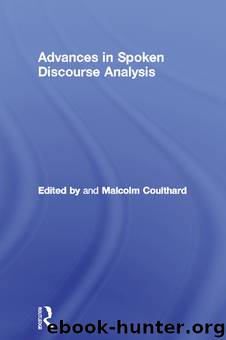Advances in Spoken Discourse Analysis by Coulthard Malcolm

Author:Coulthard, Malcolm.
Language: eng
Format: epub
ISBN: 978-1-134-91892-8
Publisher: Taylor & Francis Ltd
Interactions
Transactions combine to form the highest unit on the rank scale, the interaction. Again, however, little can be said about the internal structure of an interaction.
One problem which has been raised concerns the defining of its limits. Coulthard suggests (1981:14) that perhaps greetings and leave-takings should not be seen as part of the structure of a particular interaction, but rather as markers of the beginning and end of situations during which interactions occur. In the course of a project which involved asking doctors to record their interviews with patients, it was noted that ‘one doctor… decided that the greetings were not part of the interview and only turned on the tape-recorder after these preliminaries, while another turned off the tape-recorder before he dismissed the patient.’ Secondly, Coulthard argues, primary-school pupils usually begin and end their day by greeting and taking leave of their teacher, while in the course of the day a number of interactions—or lessons—take place which are not marked in this way.
We would not, however, wish to place greetings and leave-takings outside the limits of the interaction on the grounds that, if they are seen simply as marking the beginning and end of situations, they can no longer be subjected to internal analysis. In our data sample, there is one transaction (the last one) which is made up entirely of three Greet exchanges and one Structuring. To see a closing transaction like this (and it clearly qualifies as a transaction)2 as part of a situation but not as part of an interaction would be to ‘jump’ a rank, which is inconsistent with the fundamental principles of rank-scale analysis.
Our data sample happens to be a complete interaction; it contains ‘opening’ and ‘closing’ transactions which define the interaction boundaries. We do not wish, however, to elevate this observation into a generalization about ‘boundary transactions’, since we do not have enough data. The majority of our students’ transcripts, on the basis of which this description was formulated, did not consist of complete interactions, but were randomly selected stretches of discourse within them. A much larger body of complete interactions needs to be investigated before any structural statements as to their boundaries can be made.
Secondly, there is the question of whether interactions exhibit any further evidence of internal structure. Here the problem is that where interactions do appear to be structured, this is usually the result of situational factors. For example, the structure of a doctor—patient interview is affected by such factors as institutional setting and the goals of the participants. The fact that examination will precede diagnosis, and diagnosis will be followed by prescription has little to do with linguistic structure. And for everyday conversation, we have no evidence even of this sort of structuring.
Following Sinclair and Coulthard, then, we describe the interaction as ‘an unordered series of transactions’, bearing in mind that this does not mean that they do not display order but that this ‘order’ has not as yet been, and perhaps cannot be, characterized in linguistic terms.3
Having set
Download
This site does not store any files on its server. We only index and link to content provided by other sites. Please contact the content providers to delete copyright contents if any and email us, we'll remove relevant links or contents immediately.
Cecilia; Or, Memoirs of an Heiress — Volume 1 by Fanny Burney(32433)
Cecilia; Or, Memoirs of an Heiress — Volume 2 by Fanny Burney(31866)
Cecilia; Or, Memoirs of an Heiress — Volume 3 by Fanny Burney(31850)
The Lost Art of Listening by Michael P. Nichols(7403)
Asking the Right Questions: A Guide to Critical Thinking by M. Neil Browne & Stuart M. Keeley(5629)
We Need to Talk by Celeste Headlee(5542)
On Writing A Memoir of the Craft by Stephen King(4863)
Dialogue by Robert McKee(4321)
Pre-Suasion: A Revolutionary Way to Influence and Persuade by Robert Cialdini(4142)
I Have Something to Say: Mastering the Art of Public Speaking in an Age of Disconnection by John Bowe(3838)
Elements of Style 2017 by Richard De A'Morelli(3306)
The Book of Human Emotions by Tiffany Watt Smith(3236)
Fluent Forever: How to Learn Any Language Fast and Never Forget It by Gabriel Wyner(3024)
Name Book, The: Over 10,000 Names--Their Meanings, Origins, and Spiritual Significance by Astoria Dorothy(2938)
Good Humor, Bad Taste: A Sociology of the Joke by Kuipers Giselinde(2902)
Why I Write by George Orwell(2874)
The Art Of Deception by Kevin Mitnick(2735)
The Grammaring Guide to English Grammar with Exercises by Péter Simon(2706)
Ancient Worlds by Michael Scott(2622)
